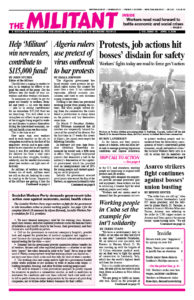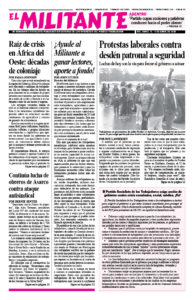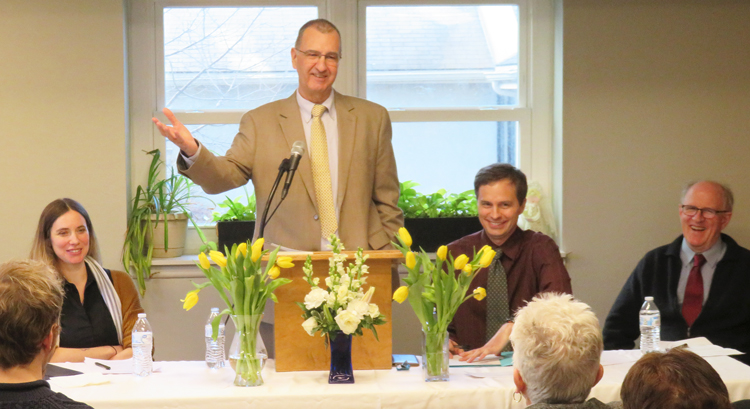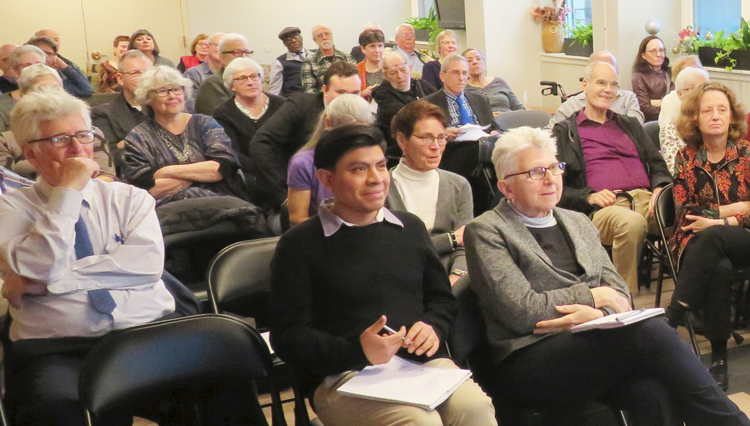ALBANY, N.Y. — More than 60 people attended a meeting at the Everly Cromwell Community Center here March 15 to celebrate the political life of Larry Quinn, a 20-year cadre of the Socialist Workers Party who died March 6.
Quinn moved to the Albany area with his companion Kathie Fitzgerald in 2018. He rejoined the party and got a job at Walmart where he participated with others in the fight for a union. Quinn helped open the SWP’s first public hall in the city in three decades.
Quinn was the 2019 SWP candidate for Troy City Council president and campaigned across the region with the party’s mayoral candidate, Samantha Hamlin.
Jacob Perasso, an SWP leader in Albany, chaired the meeting. Perasso thanked Virgia Phoenix, director of the center, for hosting the celebration, recalling the speakout against police brutality there last May that featured speakers from the Black community.
Beverly Hoggs, one of those fighters, attended the celebration. Quinn had a long history in the fight for Black rights. “He was a fighter for what he believed in,” Hoggs told this reporter. “I loved that dude.”
Workers from upstate New York, New York City, Connecticut, Massachusetts, New Jersey, Pennsylvania, Vermont, Illinois and Kentucky came to the celebration.
Mike Fitzsimmons, a leader of the Albany Medical Center nurses’ organizing drive, was also present.
Working-class line of march
Lawrence Michael Quinn was born in 1952 in Bayonne, New Jersey. He got his first job at 14 cleaning ship holds. For two decades he worked on state highways and bridges and was an active unionist.
Won as a young man to the Irish Republican movement and the fight to unite Ireland, he built solidarity with the struggles, from the 1972 Bloody Sunday massacre by British soldiers to the peace agreement in the late 1990s. He was editor of the Irish People newspaper in the 1990s.
His experiences as a worker and his growing understanding of class politics led Quinn to first join the Socialist Workers Party in 2000 and move to Pittsburgh.
From 2003 to 2017 he and Fitzgerald took responsibility for maintaining the upstate New York facility where the party organized a leadership school and editorial work.
“Larry joined the Socialist Workers Party 20 years ago to become a better fighter,” Paul Mailhot, a member of the SWP National Committee, told participants.
“His experience as a worker and a fighter for Irish freedom convinced him that only a working-class movement with a revolutionary leadership was capable of carrying the fight to the end, to the working class taking power and beginning the transformations necessary to resolve the wars, national discriminations, oppression and exploitation that capitalism brings down on working people.”
Openings to join resistance
When Quinn joined in 2000 the Socialist Workers Party was organizing the “third campaign for the turn to industry,” Mailhot said.
“There were new stirrings of resistance in the working class after a decadelong rout of the labor movement, with the most important developments in meatpacking plants, coal mines and garment factories.”
The beginning of more strikes and organizing drives posed opportunities and challenges for the party. “Larry was inspired by the prospects and quickly jumped into it, inspiring others,” Mailhot said.
“It’s an appropriate time to draw on those experiences today as party members are seeking to join struggles with co-workers around conditions on the job at Walmart and on the railroad,” said Tony Lane, an SWP leader in Pittsburgh who worked with Quinn in the mines.
“Larry helped the party establish fractions in meatpacking and coal, where conditions were very different from what he was used to.”
Quinn, Lane and Frank Forrestal, another party member, got jobs at the United Mine Workers-organized Maple Creek mine owned by coal boss Robert Murray, “where we found ourselves in the middle of a fight.” Workers at the mine forced Murray to bring pay and work rules in conformity with the prevailing union contract.
“The party ran Forrestal for mayor of Pittsburgh in 2001, in the middle of the U.S. war drive after 9/11,” Lane said. “The front page of the first Militant after 9/11 featured the miners’ fight against Murray and the statement party members used carrying out a working-class campaign against imperialism and war.”
Confidence in working class
Samantha Hamlin, now SWP candidate for Congress in Illinois, worked with Quinn in Albany.
“I joined the party at around the same time Quinn rejoined after a short time out of the party,” she said. “We both knew the decision we were making was one of confidence in the working class.”
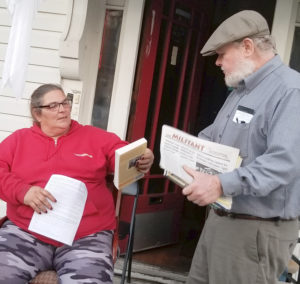
“As we were getting to know co-workers at Walmart, we built solidarity with union and social struggles,” she said. When workers at the Stop & Shop grocery chain in New England went on strike, she and Quinn and co-workers wrote solidarity messages on cards they took to strikers. They did the same for nurses at Albany Medical Center.
“Through this kind of work on the job, party members became known not only as supporters of union struggles, but as revolutionaries who take up the fight of all oppressed and exploited,” Hamlin said.
“It helped us join workers’ struggles for better conditions on the job, like a recent situation in the tire and lube department at a Walmart in Chicago where I helped lead 10 co-workers to refuse to work in sewage after being ordered to by the boss. Or the recent fight in a Walmart store in Albany where the workers waged a successful struggle to take their meal break at lunchtime — when they were actually hungry — instead of at an earlier time that the boss was trying to force.
“Through struggles like these workers gain confidence and learn how to fight,” she continued. “These are necessary battles to begin to build a union. And through them workers come to see our party as one of competent union fighters, capable of leading the struggle to overthrow capitalism and its dog-eat-dog values.”
“Quinn’s confidence in the working class shined through everything he did,” Hamlin said. “He will be deeply missed by everyone who had the honor of knowing him. And we will continue building the proletarian revolutionary movement he dedicated his life to.”
Participants in the meeting contributed $2,800 to the Socialist Workers Party.
